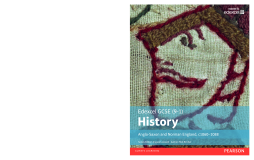
BOOK
Edexcel GCSE (9-1) History Anglo-Saxon and Norman England, c1060Ð1088 Student Book
(2017)
Additional Information
Book Details
Abstract
Exam Board: Edexcel
Level: GCSE
Subject: History
First teaching: September 2016
First exams: Summer 2018
Series Editor:Angela Leonard
This Student Book:
- covers the essential content in the new specification in an engaging way, using detailed narrative, sources, timelines, key words, helpful activities and extension material
- uses the 'Thinking Historically' approach and activities to help develop conceptual understanding of areas such as evidence, interpretations, causation and change, through targeted activities
- has 'Writing Historically' features that focus on the writing skills most important to historical success. This literacy support uses the proven Grammar for Writing approach used in many English departments
- includes lots of exam guidance, with practice questions, sources, sample answers and tips to support preparation for GCSE assessments.
* These resources have not yet been endorsed. This information is correct as of 31st July 2015, but may be subject to change. You do not have to purchase any resources to deliver our qualification.
Table of Contents
| Section Title | Page | Action | Price |
|---|---|---|---|
| Cover | Cover | ||
| Contents | 3 | ||
| Timeline | 6 | ||
| Chapter 1: Anglo-Saxon England and the Norman Conquest, 1060-66 | 8 | ||
| 1.1: Anglo-Saxon society | 9 | ||
| The social system | 9 | ||
| The power of the English monarchy | 11 | ||
| Government | 12 | ||
| The Anglo-Saxon economy | 16 | ||
| The influence of the Church | 17 | ||
| 1.2: The last years of Edward the Confessor and the succession crisis | 19 | ||
| The house of Godwin | 19 | ||
| Harold’s embassy to Normandy | 21 | ||
| The rising against Earl Tostig | 23 | ||
| Death of Edward the Confessor | 24 | ||
| 1.3: The rival claimants for the throne | 26 | ||
| Harold’s coronation and reign | 28 | ||
| The battles of Gate Fulford and Stamford Bridge | 29 | ||
| Were the battles significant? | 31 | ||
| 1.4: The Norman invasion | 32 | ||
| The Battle of Hastings (14 October 1066) | 32 | ||
| The composition of the armies | 32 | ||
| The reasons for William’s victory | 34 | ||
| Recap page | 39 | ||
| Writing Historically | 40 | ||
| Chapter 2: William I in power: securing the kingdom, 1066-87 | 42 | ||
| 2.1: Establishing control | 43 | ||
| The submission of the earls, 1066 | 43 | ||
| Rewarding followers and establishing control on the borderlands | 45 | ||
| Reasons for building castles | 48 | ||
| 2.2: The causes and outcomes of Anglo-Saxon resistance, 1068-71 | 51 | ||
| The revolt of Edwin and Morcar in 1068 | 51 | ||
| Edgar the Aethling and the rebellions in the North, 1069 | 53 | ||
| Hereward the Wake and rebellion at Ely, 1070-71 | 55 | ||
| 2.3: The legacy of resistance to 1087 | 58 | ||
| The Harrying of the North, 1069-70 | 58 | ||
| Changes in landownership from Anglo-Saxon to Norman, 1066-87 | 60 | ||
| Changes in how land was held | 62 | ||
| Maintaining royal power | 64 | ||
| 2.4: Revolt of the Earls, 1075 | 66 | ||
| The conspirators | 66 | ||
| Reasons for the revolt | 67 | ||
| The events of the revolt | 67 | ||
| The defeat of the revolt | 68 | ||
| The effects of the revolt | 70 | ||
| Recap page | 71 | ||
| Writing Historically | 72 | ||
| Chapter 3: Norman England, 1066-88 | 74 | ||
| 3.1: The feudal system and the Church | 75 | ||
| The feudal system | 75 | ||
| The nature of feudalism | 77 | ||
| The Church in England | 78 | ||
| The extent of change | 81 | ||
| 3.2: Norman government | 84 | ||
| Changes to government | 84 | ||
| The office of the sheriff and the demesne | 85 | ||
| The introduction and significance of the ‘forest’ | 86 | ||
| The Domesday Book and its significance | 88 | ||
| 3.3: The Norman aristocracy | 90 | ||
| Culture | 90 | ||
| Language | 91 | ||
| Career and significance of Bishop Odo | 92 | ||
| 3.4: William I and his sons | 94 | ||
| The character and personality of William I | 94 | ||
| Relationship with his son, Robert | 95 | ||
| William’s death and the disputed succession | 96 | ||
| William Rufus and the defeat of Robert and Odo | 96 | ||
| Recap page | 99 | ||
| Writing Historically | 100 | ||
| Anglo-Saxon and Norman England, c1060-88: Preparing for your exam | 103 | ||
| Answers | 109 | ||
| Index | 110 |
